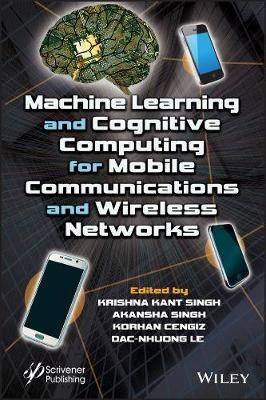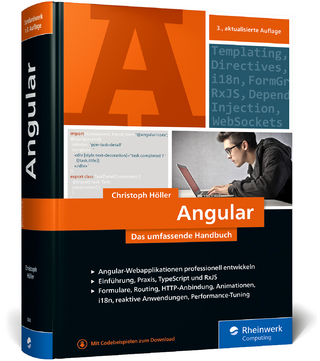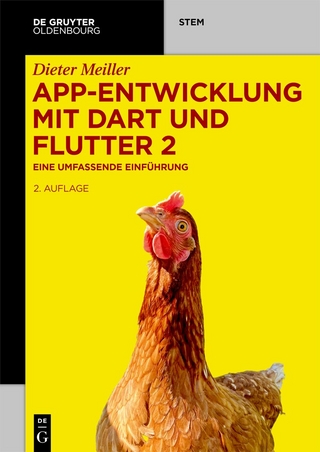
Machine Learning and Cognitive Computing for Mobile Communications and Wireless Networks
Wiley-Scrivener (Verlag)
978-1-119-64036-3 (ISBN)
Krishna Kant Singh is an Associate Professor in Electronics and Communications Engineering in KIET Group of Institutions, Ghaziabad, India. Dr. Singh has acquired BTech, MTech, and PhD (IIT Roorkee) in the area of machine learning and remote sensing. He has authored more than 50 technical books and research papers in international conferences and SCIE journals. Akansha Singh is an Associate Professor in Department of Computer Science Engineering in Amity University, Noida, India. Dr. Singh has acquired BTech, MTech, and PhD (IIT Roorkee) in the area of neural network and remote sensing. She has authored more than 40 technical books and research papers in international conferences and SCIE journals. Her area of interest includes Mobile Computing, Artificial Intelligence, Machine Learning, Digital Image Processing. Korhan Cengiz received his PhD in Electronics Engineering from Kadir Has University, Istanbul, Turkey, in 2016. He has served as keynote speakers at many conferences. His research interests include wireless sensor networks, routing protocols, wireless communications, 5G systems, statistical signal processing, and spatial modulation. Dac-Nhuong Le has a MSc and PhD in computer science from Vietnam National University, Vietnam in 2009 and 2015, respectively. He is Associate Professor in Computer Science, Deputy-Head of Faculty of Information Technology, Haiphong University, Vietnam. He has a total academic teaching experience of 12+ years with many publications in reputed international conferences, journals and online book chapters. His area of research includes: evaluation computing and approximate algorithms, network communication, security and vulnerability, network performance analysis and simulation, cloud computing, IoT and image processing in biomedical.
Preface xiii
1 Machine Learning Architecture and Framework 1
Nilanjana Pradhan and Ajay Shankar Singh
1.1 Introduction 2
1.2 Machine Learning Algorithms 3
1.2.1 Regression 3
1.2.2 Linear Regression 4
1.2.3 Support Vector Machine 4
1.2.4 Linear Classifiers 5
1.2.5 SVM Applications 8
1.2.6 Naïve Bayes Classification 8
1.2.7 Random Forest 9
1.2.8 K-Nearest Neighbor (KNN) 9
1.2.9 Principal Component Analysis (PCA) 9
1.2.10 K-Means Clustering 10
1.3 Business Use Cases 10
1.4 ML Architecture Data Acquisition 14
1.5 Latest Application of Machine Learning 15
1.5.1 Image Identification 16
1.5.2 Sentiment Analysis 16
1.5.3 News Classification 16
1.5.4 Spam Filtering and Email Classification 17
1.5.5 Speech Recognition 17
1.5.6 Detection of Cyber Crime 17
1.5.7 Classification 17
1.5.8 Author Identification and Prediction 18
1.5.9 Services of Social Media 18
1.5.10 Medical Services 18
1.5.11 Recommendation for Products and Services 18
1.5.11.1 Machine Learning in Education 19
1.5.11.2 Machine Learning in Search Engine 19
1.5.11.3 Machine Learning in Digital Marketing 19
1.5.11.4 Machine Learning in Healthcare 19
1.6 Future of Machine Learning 20
1.7 Conclusion 22
References 23
2 Cognitive Computing: Architecture, Technologies and Intelligent Applications 25
Nilanjana Pradhan, Ajay Shankar Singh and Akansha Singh
2.1 Introduction 26
2.1 The Components of a Cognitive Computing System 27
2.3 Subjective Computing Versus Computerized Reasoning 28
2.4 Cognitive Architectures 29
2.5 Subjective Architectures and HCI 31
2.6 Cognitive Design and Evaluation 32
2.6.1 Architectures Conceived in the 1940s Can’t Handle the Data of 2020 41
2.7 Cognitive Technology Mines Wealth in Masses of Information 41
2.7.1 Technology is Only as Strong as Its Flexible, Secure Foundation 42
2.8 Cognitive Computing: Overview 43
2.9 The Future of Cognitive Computing 47
References 49
3 Deep Reinforcement Learning for Wireless Network 51
Bharti Sharma, R.K Saini, Akansha Singh and Krishna Kant Singh
3.1 Introduction 51
3.2 Related Work 54
3.3 Machine Learning to Deep Learning 55
3.3.1 Advance Machine Learning Techniques 56
3.3.1.1 Deep Learning 56
3.3.2 Deep Reinforcement Learning (DRL) 57
3.3.2.1 Q-Learning 58
3.3.2.2 Multi-Armed Bandit Learning (MABL) 58
3.3.2.3 Actor–Critic Learning (ACL) 58
3.3.2.4 Joint Utility and Strategy Estimation Based Learning 59
3.4 Applications of Machine Learning Models in Wireless Communication 59
3.4.1 Regression, KNN and SVM Models for Wireless 60
3.4.2 Bayesian Learning for Cognitive Radio 60
3.4.3 Deep Learning in Wireless Network 61
3.4.4 Deep Reinforcement Learning in Wireless Network 62
3.4.5 Traffic Engineering and Routing 63
3.4.6 Resource Sharing and Scheduling 64
3.4.7 Power Control and Data Collection 64
3.5 Conclusion 65
References 66
4 Cognitive Computing for Smart Communication 73
Poonam Sharma, Akansha Singh and Aman Jatain
4.1 Introduction 74
4.2 Cognitive Computing Evolution 75
4.3 Characteristics of Cognitive Computing 76
4.4 Basic Architecture 77
4.4.1 Cognitive Computing and Communication 77
4.5 Resource Management Based on Cognitive Radios 78
4.6 Designing 5G Smart Communication with Cognitive Computing and AI 80
4.6.1 Physical Layer Design Based on Reinforcement Learning 82
4.7 Advanced Wireless Signal Processing Based on Deep Learning 84
4.7.1 Modulation 85
4.7.2 Deep Learning for Channel Decoding 86
4.7.3 Detection Using Deep Learning 87
4.8 Applications of Cognition-Based Wireless Communication 87
4.8.1 Smart Surveillance Networks for Public Safety 88
4.8.2 Cognitive Health Care Systems 88
4.9 Conclusion 89
References 89
5 Spectrum Sensing and Allocation Schemes for Cognitive Radio 91
Amrita Rai, Amit Sehgal, T.L. Singal and Rajeev Agrawal
5.1 Foundation and Principle of Cognitive Radio 92
5.2 Spectrum Sensing for Cognitive Radio Networks 94
5.3 Classification of Spectrum Sensing Techniques 95
5.4 Energy Detection 97
5.5 Matched Filter Detection 100
5.6 Cyclo-Stationary Detection 103
5.7 Euclidean Distance-Based Detection 107
5.8 Spectrum Allocation for Cognitive Radio Networks 108
5.9 Challenges in Spectrum Allocation 118
5.9.1 Spectrum and Network Heterogeneity 119
5.9.2 Issues and Challenges 120
5.10 Future Scope in Spectrum Allocation 122
References 123
6 Significance of Wireless Technology in Internet of Things (IoT) 131
Ashish Tripathi, Arun Kumar Singh, Pushpa Choudhary, Prem Chand Vashist and K. K. Mishra
6.1 Introduction 132
6.1.1 Internet of Things: A Historical Background 133
6.1.2 Internet of Things: Overview, Definition, and Understanding 133
6.1.3 Internet of Things: Existing and Future Scopes 135
6.2 Overview of the Hardware Components of IoT 136
6.2.1 IoT Hardware Components: Development Boards/Platforms 136
6.2.1.1 Arduino 136
6.2.1.2 Raspberry Pi 137
6.2.1.3 BeagleBone 137
6.2.2 IoT Hardware Components: Transducer 138
6.2.2.1 Sensors 138
6.2.2.2 Actuators 138
6.3 Wireless Technology in IoT 139
6.3.1 Topology 139
6.3.1.1 Mesh Topology 140
6.3.1.2 Star Topology 141
6.3.1.3 Point-to-Point Topology 141
6.3.2 IoT Networks 142
6.3.2.1 Nano Network 142
6.3.2.2 Near-Field Communication (NFC) Network 143
6.3.2.3 Body Area Network (BAN) 143
6.3.2.4 Personal Area Network (PAN) 143
6.3.2.5 Local Area Network (LAN) 143
6.3.2.6 Campus/Corporate Area Network (CAN) 143
6.3.2.7 Metropolitan Area Network (MAN) 144
6.3.2.8 Wide Area Network (WAN) 144
6.3.3 IoT Connections 144
6.3.3.1 Device-to-Device (D2D)/Machine-to-Machine (M2M) 144
6.3.3.2 Machine-to-Gateway/Router (M2G/R) 145
6.3.3.3 Gateway/Router-to-Data System (G/R2DS) 145
6.3.3.4 Data System to Data System (DS2DS) 145
6.3.4 IoT Protocols/Standards 145
6.3.4.1 Network Protocols for IoT 146
6.3.4.2 Data Protocols for IoT 148
6.4 Conclusion 150
References 150
7 Architectures and Protocols for Next-Generation Cognitive Networking 155
R. Ganesh Babu, V. Amudha and P. Karthika
7.1 Introduction 156
7.1.1 Primary Network (Licensed Network) 156
7.1.2 CR Network (Unlicensed Network) 157
7.2 Cognitive Radio Network Technologies and Applications 159
7.2.1 Classes of CR 159
7.2.2 Next Generation (xG) of CR Applications 162
7.3 Cognitive Computing: Architecture, Technologies, and Intelligent Applications 163
7.3.1 CR Physical Architecture 163
7.4 Functionalities of CR in NeXt Generation (xG) Networks 164
7.5 Spectrum Sensing 165
7.5.1 Spectrum Decision 165
7.5.2 Spectrum Mobility 165
7.5.3 CR Network Functions 166
7.6 Cognitive Computing for Smart Communications 167
7.6.1 CR Technologies 167
7.7 Spectrum Allocation in Cognitive Radio 169
7.8 Cooperative and Cognitive Network 173
7.8.1 Cooperative Centralized Coordinated 173
7.8.2 Cooperative Decentralized (Distributed) Coordinated and Uncoordinated 176
References 176
8 Analysis of Peak-to-Average Power Ratio in OFDM Systems Using Cognitive Radio Technology 179
Udayakumar Easwaran, Poongodi Palaniswamy and Vetrivelan Ponnusamy
8.1 Introduction 180
8.2 OFDM Systems 181
8.3 Peak-to-Average Power Ratio 183
8.4 Cognitive Radio (CR) 184
8.5 Related Works 186
8.6 Neural Network System Model 193
8.7 Complexity Examination 194
8.8 PAPR and BER Examination 195
8.9 Performance Evaluation 196
8.10 Results and Discussions 196
8.11 Conclusion 200
References 200
9 A Threshold-Based Optimization Energy-Efficient Routing Technique in Heterogeneous Wireless Sensor Networks 203
Samayveer Singh
9.1 Introduction 204
9.2 Literature Review 205
9.3 System Model 207
9.3.1 Four-Level Heterogeneous Network Model 208
9.3.2 Energy Dissipation Radio Model 210
9.4 Proposed Work 211
9.4.1 Optimum Cluster Head Election of the Proposed Protocol 211
9.4.2 Information Congregation and Communication Process Based on Chaining System for Intra and Inter‑Cluster Communication 214
9.4.3 The Complete Working Process of the Proposed Method 214
9.5 Simulation Results and Discussions 216
9.5.1 Network Lifetime and Stability Period 217
9.5.2 Network Outstanding Energy 219
9.5.3 Throughput 219
9.5.4 Comparative Analysis of the Level-4 Network Protocols 222
9.6 Conclusion 222
References 223
10 Efficacy of Big Data Application in Smart Cities 225
Sudipta Sahana, Dharmpal Singh and Pranati Rakshit
10.1 Introduction 226
10.1.1 Characteristics of Big Data 227
10.1.1.1 Velocity 227
10.1.1.2 Volume 227
10.1.1.3 Value 228
10.1.1.4 Variety 228
10.1.1.5 Veracity 228
10.1.2 Definition of Smart Cities 228
10.2 Types of Data in Big Data 229
10.2.1 Structured Data 229
10.2.2 Unstructured Data 230
10.2.3 Semi-Structured Data 230
10.3 Big Data Technologies 231
10.3.1 Apache Hadoop 231
10.3.2 HDFS 231
10.3.3 Spark 232
10.3.4 Microsoft HDInsight 232
10.3.5 NoSQL 233
10.3.6 Hive 233
10.3.7 Sqoop 234
10.3.8 R 235
10.3.9 Data Lakes 235
10.4 Data Source for Big Data 235
10.4.1 Media 236
10.4.2 Cloud 236
10.4.3 The Web 236
10.4.4 IOT 236
10.4.5 Databases as a Big Data Source 237
10.4.6 Hidden Big Data Sources 237
10.4.6.1 Email 237
10.4.6.2 Social Media 238
10.4.6.3 Open Data 238
10.4.6.4 Sensor Data 238
10.4.7 Application-Oriented Big Data Source for a Smart City 238
10.4.7.1 Healthcare 238
10.4.7.2 Transportation 239
10.4.7.3 Education 240
10.5 Components of a Smart City 241
10.5.1 Smart Infrastructure 241
10.5.1.1 Intelligent Lighting 241
10.5.1.2 Modern Parking Systems 241
10.5.1.3 Associated Charging Points 242
10.5.2 Smart Buildings and Belongings 242
10.5.2.1 Safety and Security Systems 242
10.5.2.2 Smart Sprinkler Systems for Gardens 242
10.5.2.3 Smart Heating and Ventilation 242
10.5.3 Smart Industrial Environment 243
10.5.4 Smart City Services 243
10.5.4.1 Smart Stalls 243
10.5.4.2 Monitoring of Risky Areas 244
10.5.4.3 Public Safety 244
10.5.4.4 Fire/Explosion Management 244
10.5.4.5 Automatic Health-Care Delivery 244
10.5.5 Smart Energy Management 244
10.5.5.1 Smart Grid 245
10.5.5.2 Intelligent Meters 245
10.5.6 Smart Water Management 245
10.5.7 Smart Waste Management 245
10.6 Challenge and Solution of Big Data for Smart City 246
10.6.1 Challenge in Big Data for Smart City 246
10.6.1.1 Data Integration 246
10.6.1.2 Security and Privacy 246
10.6.1.3 Data Analytics 247
10.6.2 Solution of Challenge Smart City 247
10.6.2.1 Conquering Difficulties with Enactment 247
10.6.2.2 Making People Smarter—Education for Everyone 248
10.7 Conclusion 248
References 249
Index 251
| Erscheinungsdatum | 02.09.2020 |
|---|---|
| Sprache | englisch |
| Maße | 10 x 10 mm |
| Gewicht | 454 g |
| Themenwelt | Informatik ► Software Entwicklung ► Mobile- / App-Entwicklung |
| Informatik ► Theorie / Studium ► Künstliche Intelligenz / Robotik | |
| ISBN-10 | 1-119-64036-9 / 1119640369 |
| ISBN-13 | 978-1-119-64036-3 / 9781119640363 |
| Zustand | Neuware |
| Haben Sie eine Frage zum Produkt? |
aus dem Bereich


